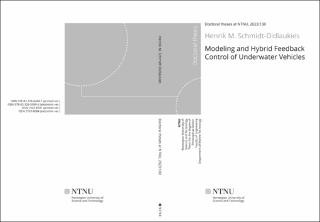| dc.description.abstract | This thesis presents contributions to the mathematical modeling of underwater vehicles and nonlinear hybrid feedback control. We present a matrix Lie group formulation of the standard model describing the motion of rigid underwater vehicles. Furthermore, we introduce monotone dissipativity, a specialization of the standard notion of dissipativity, which is useful for the stability analysis of underwater vehicle control systems. It is shown that common formulations of hydrodynamic damping experienced by underwater vehicles are not merely dissipative, but in fact monotonically dissipative. We then investigate a fundamental relationship between convexity properties of Rayleigh dissipation functions and monotonically dissipative hydrodynamic damping models. The Lie group formulation of the underwater vehicle dynamics also makes possible a complete and precise description of vehicle shape symmetry, and its role in simplifying the modeling of hydrodynamic inertia and damping effects.
An extension of the aforementioned modeling framework to underwater vehicles that are multibody systems with a kinematic tree structure is subsequently formulated. This class of underwater vehicles includes not only conventional underwater vehiclemanipulator systems, but also a large number of experimental and prototype designs such as articulated intervention autonomous underwater vehicles. A global matrixform of the vehicle kinematics and dynamics which is well-suited to stability analysis of model-based control laws is derived. Furthermore, we introduce a generalized inverse dynamics algorithm that simplifies the implementation of such control laws. The forward dynamics problem is addressed in an efficient manner with a composite-rigidbody algorithm.
Hybrid feedback control laws typically comprise a collection of continuous state feedback control laws in conjunction with a state-based switching logic that determines which control law from the collection is utilized. We employ hybrid feedback control to circumvent topological obstructions to robust global stabilization which are associated, for example, with the rotational degrees of freedom of marine vehicles. In particular, we formulate globally asymptotically stabilizing proportional-derivative (PD), output feedback, and proportional-derivative-integral (PID) hybrid feedback control laws, which solve the tracking problem globally and robustly for a class of mechanical control systems defined on matrix Lie groups. These control laws are constructed from so-called synergistic functions, which have already been derived for the Lie groups that describe the configuration space of many important engineering systems. The presented control laws therefore have immediate and wide applicability.
We also present specialized adaptive hybrid feedback control laws for marine surface and underwater vehicles, which we derive from a slightly more general class of functions than the aforementioned synergistic ones. The introduced control laws can be loosely characterized as being of dynamic sliding-surface type, and ensure global asymptotic path-following for the marine vehicles in the presence of parametric modeling uncertainties. In contrast to conventional synergistic backstepping control laws, the sliding surface formulation results in a switching logic which is independent of the vehicle velocities. While this feature comes at the cost of a minor increase in dynamic order of the control law, it permits the estimation of the vehicle’s inertial parameters. Experimental validation of the derived control laws are presented for surface and underwater vehicles.
We subsequently introduce hysteretic control Lyapunov functions (HCLFs). A family of HCLFs consists of several locally defined control Lyapunov functions. A switching logic with hysteresis is encoded in three finite covers of the state-space on which the control Lyapunov functions satisfy certain decrease conditions. We investigate the relationship between HCLFs and synergistic control Lyapunov functions (SCLFs), and show that a family of HCLFs generalizes an SCLF whose synergy gap is bounded away from zero. Furthermore, given an HCLF family, we derive sufficient conditions for the existence of globally asymptotically stabilizing hybrid feedbacks. Lastly, we provide a constructive optimization-based design procedure for such stabilizing hybrid feedbacks.
The last chapter of this thesis presents a generalization of synergistic Lyapunov function and feedback (SLFF) pairs, which in turn are a generalization of the aforementioned synergistic functions. In particular, we allow the logic variable paramount to traditional synergistic control to possess flow dynamics, thereby translating SLFF pairs into SLFF triples. The generalized logic state is referred to as a synergy variable, for which we introduce the two modified jumping strategies optional jumping and independently triggered jumping. Moreover, it is shown that SLFF triples, like SLFF pairs, are amenable to integrator backstepping. We demonstrate the usefulness of the proposed framework by constructing a globally stabilizing synergistic maneuvering control law for surface vessels that allows optional jumps of the path parameter. | en_US |
